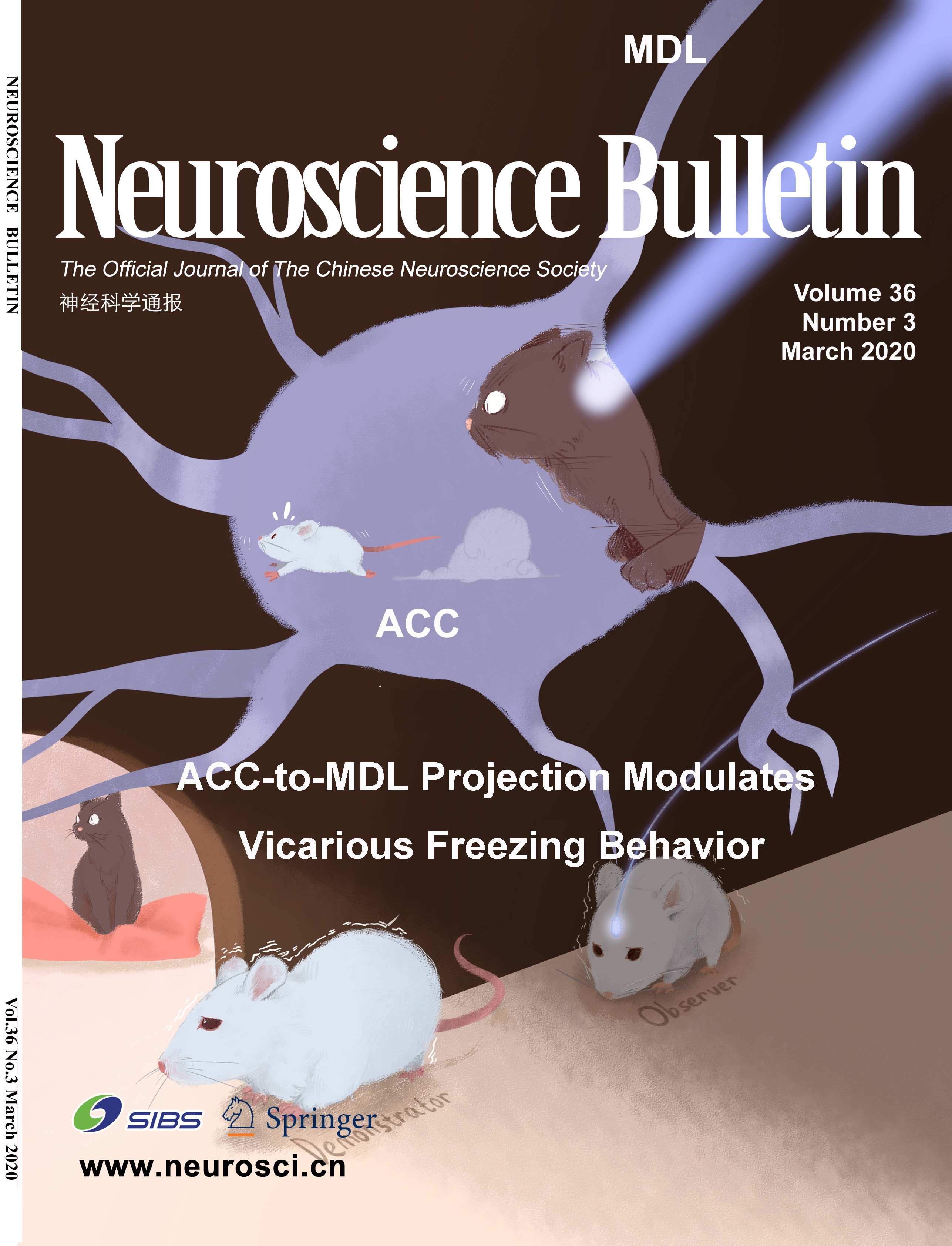Neuronal Network Dissection with Neurotropic Virus Tracing
Xiaoping Rao • Jie Wang
2020, 36(3): 199-201 [
Abstract] [
SpringerLink]
[PDF]
Rabies Virus Pseudotyped with CVS-N2C Glycoprotein as a Powerful Tool for Retrograde Neuronal Network Tracing
Xutao Zhu • Kunzhang Lin • Qing Liu • Xinpei Yue • Huijie Mi • Xiaoping Huang • Xiaobin He • Ruiqi Wu • Danhao Zheng • Dong Wei • Liangliang Jia • Weilin Wang • Anne Manyande • Jie Wang • Zhijian Zhang • Fuqiang Xu
2020, 36(3): 202-217 [
Abstract] [
SpringerLink]
[PDF]
Projection from the Anterior Cingulate Cortex to the Lateral Part of Mediodorsal Thalamus Modulates Vicarious Freezing Behavior
Chaowen Zheng • Yanwang Huang • Binshi Bo • Lei Wei• Zhifeng Liang • Zuoren Wang
2020, 36(3): 217-230 [
Abstract] [
SpringerLink]
[PDF]
Dopamine D2 Receptor-Mediated Modulation of Rat Retinal Ganglion Cell Excitability
Ning Yin • Yu-Long Yang • Shuo Cheng • Hong-Ning Wang • Xin Hu • Yanying Miao • Fang Li • Zhongfeng Wang
2020, 36(3): 230-242 [
Abstract] [
SpringerLink]
[PDF]
Scorpion Venom Heat-Resistant Peptide is Neuroprotective against Cerebral Ischemia-Reperfusion Injury in Association with the NMDA-MAPK Pathway
Xu-Gang Wang • Dan-Dan Zhu • Na Li • Yue-Lin Huang • Ying-Zi Wang • Ting Zhang • Chen-Mei Wang • Bin Wang • Yan Peng • Bi-Ying Ge • Shao Li • Jie Zhao
2020, 36(3): 243-253 [
Abstract] [
SpringerLink]
[PDF]
AVP(4-8) Improves Cognitive Behaviors and Hippocampal Synaptic Plasticity in the APP/PS1 Mouse Model of Alzheimer’s Disease
Xiumin Zhang• Fang Zhao • Chenfang Wang • Jun Zhang • Yu Bai • Fang Zhou • Zhaojun Wang• Meina Wu • Wei Yang • Junhong Guo • Jinshun Qi
2020, 36(3): 254-262 [
Abstract] [
SpringerLink]
[PDF]
Role of Elevated Thrombospondin-1 in Kainic Acid-Induced Status Epilepticus
Yurong Zhang • Mengdi Zhang • Wei Zhu • Xiaohong Pan • Qiaoyun Wang• Xue Gao • Chaoyun Wang• Xiuli Zhang • Yuxia Liu • Shucui Li • Hongliu Sun
2020, 36(3): 263-276 [
Abstract] [
SpringerLink]
[PDF]
NLRP3 Deficiency Attenuates Secondary Degeneration of Visual Cortical Neurons Following Optic Nerve Injury
Zhou Zhang • Wenyi Liu • Yubin Huang• Linlin Luo• Xiaofeng Cai • Yunjia Liu • Liqianyu Ai • Jun Yan • Sen Lin • Jian Ye
2020, 36(3): 277-288 [
Abstract] [
SpringerLink]
[PDF]
Propofol Attenuates a-Synuclein Aggregation and Neuronal Damage in a Mouse Model of Ischemic Stroke
Yuzhu Wang • Dan Tian • Changwei Wei • Victoria Cui • Huan Wang • Yanbing Zhu • Anshi Wu • Yun Yue
2020, 36(3): 289-298 [
Abstract] [
SpringerLink]
[PDF]
Microglia Research in the 100th Year Since Its Discovery
Anthony D. Umpierre • Long-Jun Wu
2020, 36(3): 303-306 [
Abstract] [
SpringerLink]
[PDF]
The Risk and Prevention of Novel Coronavirus Pneumonia Infections Among Inpatients in Psychiatric Hospitals
Yuncheng Zhu • Liangliang Chen • Haifeng Ji • Maomao Xi • Yiru Fang • Yi Li
2020, 36(3): 299-302 [
Abstract] [
SpringerLink]
[PDF]
Expert Consensus on the Care and Management of Patients with Cognitive Impairment in China
Academy of Cognitive Disorders of China (ACDC) • Yuliang Han • Jianjun Jia • Xia Li • Yang Lv • Xuan Sun • Shanshan Wang• Yongjun Wang • Zhiwen Wang • Jintao Zhang • Jiong Zhou • Yuying Zhou
2020, 36(3): 307-320 [
Abstract] [
SpringerLink]
[PDF]
A Review of Functional Near-Infrared Spectroscopy Studies of Motor and Cognitive Function in Preterm Infants
Quan Wang • Guang-Pu Zhu • Li Yi • Xin-Xin Cui • Hui Wang • Ru-Yi Wei • Bing-Liang Hu
2020, 36(3): 321-329 [
Abstract] [
SpringerLink]
[PDF]
